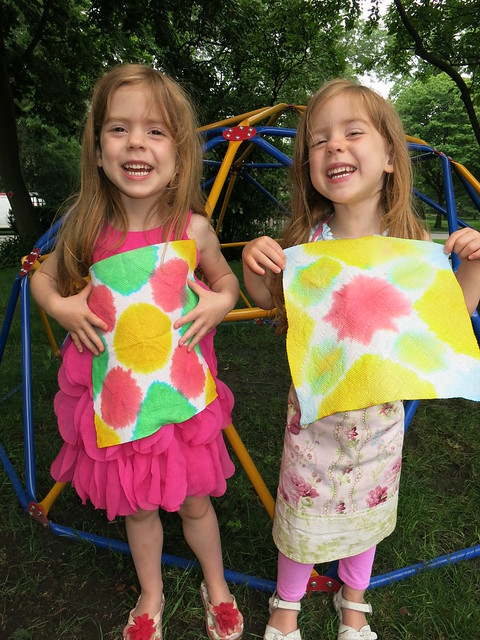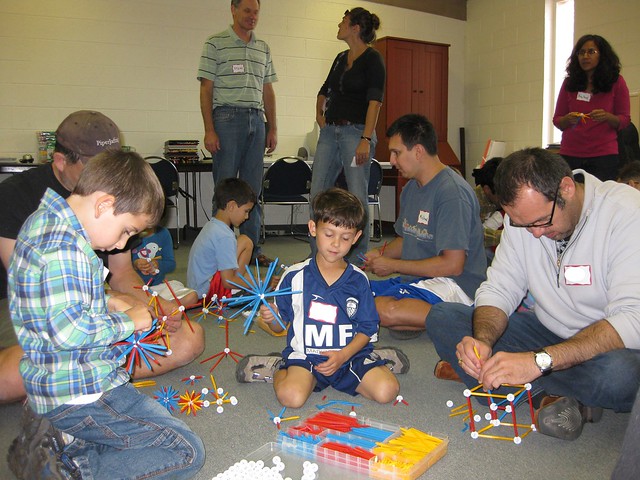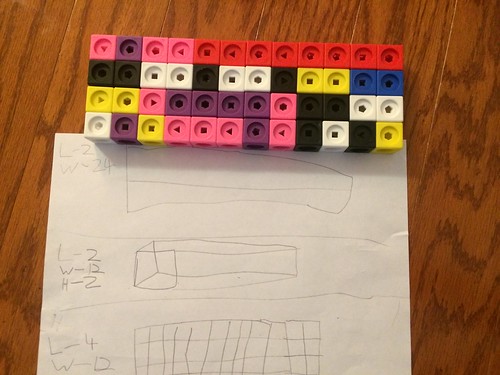Shapes Out Of Shapes
What do you see?
People see shapes everywhere. Our minds deal with any visual experience by forming meaningful patterns, using a system called object recognition. Most of the time, we are not aware of this process. But you can make a game out of recognizing and making shapes and patterns.
Take this squash, for example. It doesn’t look much like squash, does it? It looks more like a duck. Because our minds analyze shapes automatically, we see all sorts of shapes where we don’t even expect them to be: a vegetable becomes an animal.
We recognize a shape by association with a shape we’ve already seen. You can invite your kids to play recognition games with potatoes and squash at the grocery store, or clouds and tree bark at the park. Or if your kid is a night-time person, people have been looking for shapes in the stars for thousands of years! At home, make random doodles, paint blots, or clay blobs and ask, “What Do You See?” Share what you see, when you are the one to catch a shape: “The stem of the squash is perfect for duck’s beak, because both are flattened cones.” Talking helps everybody, kids and adults, to grow their math eyes.
A shape is just a shape until…
But object recognition is only the first step! Take the game to the next level by adding your own details to the image your mind just found. Several teachers call this game “A Shape Is Just A Shape Until…”
From A Shape Is Just A Shape PDF book, by the kindergarteners at Stony Point Elementary School
From Bishop’s Blackboard 1st grade
This game gives kids more freedom to tweak and customize shapes than “What Do You See?” does. A shape is just a shape until you add more shapes. Then that shape can be anything!
Integrate in style
The two games I’ve described so far are easy and meditative, because human minds automatically recognize objects. Even newborns are good at that. But building totally new objects out of simple parts is much more challenging. Instead of seeing an existing shape, you need to make a new shape in your mind, as you build or draw it. Since people enjoy challenges, many cultures around the world have games and craft traditions for integrating shapes out of shapes.
From “Tangram” by Wanda Copier
Have you ever played with tangrams? The Chinese game of tangrams is about making shapes out of seven pieces called tans, without the pieces overlapping. Some shapes are abstract, but others are images of animals, birds, houses, and so on. The traditional collections of shapes are like galleries of impressionist miniatures.
In one version of the tangram game, you are given silhouettes of shapes. You have to reverse-engineer them to figure out how to make the same shape out of the tans. Some shapes are easy to make, others can take hours to figure out.
Another tangram game is to build your own silhouettes out of the seven tans. It doesn’t sound complex, but there are hundreds of different shapes that can be constructed with tans, and thousands of variations. Of course, you don’t have to play by these rules all the time. See what kind of shapes your kids can invent with more than seven pieces, or with overlaps.
If you or your kid want to look at more complex shapes out of shapes, try drawing celtic knotwork. Even the most complex knotwork is made of simple shapes repeating throughout the pattern.
If you or your kid are having a bit of trouble replicating knotwork, try using a grid. Grids help with keeping neat the lines, the angles, and the topology of the knots. Thinky Things has a database of instructions for learning how to draw knotwork.
As with tangrams, you can design abstract knots or flowers, animals, and people. One thing is consistent though: no matter the shape of the final product, each finished knot was built out of smaller shapes!
There are many paths to a single destination. How do you make a bird? Sometimes it’s as simple as walking through the supermarket and seeing a tomato that looks like a duck. Or you can go back in time through hundreds of years, to ancient China or Celtic Europe, and make birds out of tangrams or knotwork. Or, if you don’t want to go to the trouble of building a time machine, modern tools such as LEGO and Minecraft are all about making shapes out of shapes.
While learning about shapes out of shapes, your kid will be practicing object recognition, pattern-making, analysis, and synthesis, all of which are used by mathematicians, engineers, and countless other professions. Every time you see a 3D animation, walk across a bridge, or explore an aviary, you are seeing the product of a mind making shapes out of other shapes.
Posted in Make
Jobs for kids: here, now, and in sci-fi futures
In a Berkeley study, 4-year-olds outperformed adults at problem-solving that required unexpected moves. What if each engineer played with a couple of young kids to work though tough design challenges? #JobsForKids: Scout of Unlikely Possibilities.
A designer dad invited his 5-year-old, and an illustrator mom her 4-year-old, to pass the work back and forth. Deeply original stories, poems, and drawings emerged, reaching worldwide renown. What if art, design, and architecture studios had kid artists on premises? #JobsForKids: Surrealist Artist.
In our upcoming book, Problem-Solving for the Young, we describe the complementary roles of kids and adults in harmonious mixed-age math circles. Here is the table:
| Adults | Children | |
| Ideas | Write ideas down, sort and organize sets of examples, articulate knowledge | Generate diverse, creative, novel, unexpected ideas |
| Mathematics | Maintain consistency of patterns, extend patterns with new examples | Open up and maintain free play, break patterns to create new patterns |
| Process | Organize the process, manage time and tasks, maintain group well-being, nurture | Sense poor management practices, quickly react to dangers (“the canary”), invoke empathy and joy |
| Applications | Connect ideas to many life experiences and examples | Connect ideas to unexpected examples, look at familiar things from new angles |
| Aesthetics | Appreciate order and systems | Appreciate beauty and adventure |
Has your child ever surprised you with a clever solution to a home improvement dilemma?
Is your toddler better at conflict resolution than your whole HR department?
Can you see the future where kids fully participate in advanced, professional, math-rich endeavors?
Send us examples for our new #JobsForKids collection!
Email moby@moebiusnoodles.com or leave a comment.
Posted in Grow
Playing With Math: Newsletter July 1, 2014
Subscribe to newsletters
Pinterest | Twitter | Facebook | Google+
Hi, I am Moby Snoodles, and this is news about Natural Math.
Send me your questions, comments, and stories of math adventures at moby@moebiusnoodles.com

Playing With Math

We at Natural Math are at it again: producing and publishing an innovative, playful, Creative Commons book, crowdsourced and crowdfunded. Playing With Math: Stories from Math Circles, Homeschoolers, and Passionate Teachers is edited by our Sue VanHattum, with more than fifty people contributing stories, art, puzzles, and lots of math love. You can read more details and contribute to the campaign at IncitED.
This is a much anticipated book, about five years in the making. That’s why there are a lot of excited reviews, and more than half of the target amount collected in just the first week of the campaign. I would like to share quotes from a few of my favorite reviews:
To know Sue is to know that she loves teaching and learning mathematics, and she loves writing, therefore this book — this work of consummate love — has to happen. Playing With Math is really a collection of love stories because the authors, including yours truly, want to share something we’re pretty crazy about. It’s the stuff we do beyond the regular school day — we play with math after hours, at the dinner table, on a napkin at the coffee shop, with our own child or with a neighbor’s child, at a family picnic, with our in-laws whom we don’t even like. – Fawn Nguyen, math teacher
“Math-play adventures.” What an inviting phrase. What a promise, what a fundamentally different, and desperately needed vision of what we could be teaching when we teach math! If play is important to you, if learning, if your children are important, this book could restore your hope, or at least reassure you that there are alternatives, effective, tested, and meaningfully playful alternatives, alternatives that you and your children’s teachers can put into place, immediately. – Bernard De Koven, researcher and author
Each chapter of Playing With Math is written by someone not very different from you: parents who have formed kids’ math clubs, homeschoolers who foster math enthusiasm, and teachers who use math in unexpected ways. The book includes puzzles, games, and other activities as well as a wealth of online resources. It also offers something more vital. The real-life experiences shared by the book’s 30 authors enlarge our vision of the role math can play in our lives, one that’s joyfully creative as well as purposeful. – Laura Grace Weldon, author and GeekMom editor
1001 circles: your math adventures
Bill M. from Chicago emailed about trying out different symmetry activities with his twins: “My two 4-year old girls did not really dig the “symmetry miming exercise” [from the Moebius Noodles book – Moby], but I found something that they enjoyed: folding up paper towels (by squares, by triangles) and dipping each corner into colored liquid. We used water and food coloring like tie-dye. The result was colorful and symmetrical. We could play with symmetry across the various axes and try folding into various shapes to see how it would, literally, unfold. A tip: use lots of food coloring to make rich colors. ”

I love to see kids laughing out loud because they are happy about their math! Check out the cool 3D mesh climbing structure in the background, for body-scale math adventures.

Stephen Taylor is an enthusiastic dad who happens to be an engineer and loves math. Read his guest post for our blog, sharing detailed know-how about running Zometool workshops. Want to try leading your first group event? A one-time, free-building workshop for your children’s friends or classmates is an excellent format. Stephen writes: “I chose a workshop format of “discovery learning” in which just enough guidance is provided to the kids to stimulate their own thinking and creating. I wanted the setting to be very “real world”, like an architect’s studio or a scientist’s lab.”

Naveen posted a question to our Ask and Tell forum: “I had asked a open question to my 7 year old son and asked him to make a rectangle with 48 pieces of snapping cubes. He came up with lots of fun ways and really enjoyed it. Would anyone have suggestions for open challenges with the snap cubes?” Answer Naveen’s question, or see what ideas others shared.
Sharing
You are welcome to share the contents of this newsletter online or in print.
Talk to you soon! Moby Snoodles, aka Dr. Maria Droujkova
Posted in Newsletter
Math mind hack: Mention these things to make your kids instantly lose their math abilities
We’ve all been there: you feel especially smart and funny when talking to a particular person, only to feel hopelessly unintelligent and inarticulate in the presence of another.
Remind your daughter that girls are smart before she starts on a math problem.
Put up a new poster about race in your classroom.
Give your student a compliment about the new haircut.
Good advice? NO! You just shrunk children’s math and science skills by 10-30% or more. This treacherous effect, called stereotype threat, applies instantly and can linger for hours. It is especially strong in people who are already struggling with mathematics, but it even works on math professors.
As more people become aware of the danger, policies change. Our author Rachel Steinig gave an interview to The NY Times and then to Good Morning America about a “No Body Talk” policy at a summer camp. A quote from Rachel:
People really like me for who I am and not what I look like, and people actually pay attention to the sort of person that I am. Your dress isn’t really you, it’s just something you bought. But whether you are a good friend, that’s truly you.
Researchers don’t know yet why the mere mention of appearance, gender, or race makes math harder, but there are two clues. First, being reminded of social issues can induce fear, hence the name “stereotype threat”. Any fear reduces activity in parts of the brain involved in problem-solving. More broadly, studies in social information processing hint that it activates different parts of the brain than mathematical problem-solving does. Even a fearless brain wastes tons of resources switching from graphing a function to pondering how women function in the society.
Should you altogether avoid talking about race, gender, or appearance? Not at all. Kids need to discuss key social issues in their lives. But do keep these social discussions away from math adventures and science explorations. People sometimes make fun of stereotypical scientists who don’t give proper compliments, or wear drab clothes, and ignore other social clues. Maybe muting “social noise” helps you keep your math abilities.
What can you teach kids about protection from this effect? Here are three self-help ideas.
- Anchor your mind in its mathematical state. Let the distraction pass over you, and keep your attention on task. Many mindfulness practices give tools for conscious control of attention.
- Counter fears with value affirmation. Remind yourself who you truly are and what you truly want.
- Help others to learn about stereotype threats. Tell them about this mind hack – but not while they are doing mathematics!

Posted in Grow















